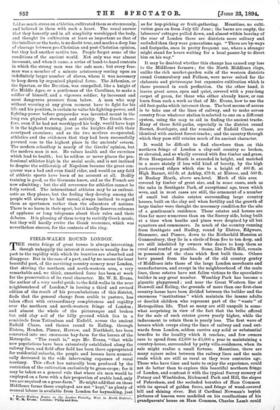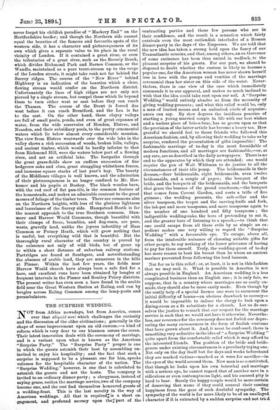FIELD-WALKS ROUND LONDON.
THE rustic fringe of great towns is always interesting, though unhappily the interest it creates is usually due in part to the rapidity with which its beauties are absorbed and disappear. But in the case of apart, and by no means the least beautiful part, of the surviving country scenery near London, that skirting the northern and north-western area, a very remarkable and, we think, unnoticed force has been at work for the preservation of its rural character. Mr. W. R. Evans, the author of a very useful guide to the field-walks in the near neighbourhood of London,* in issuing a third and revised edition of the result of his perambulations of this district, finds that the general change from arable to pasture, has taken effect with extraordinary completeness and rapidity over the northern and north-western fringe of London ; and almost the whole of the picturesque and broken but cold clay soil of the billy ground which lies in a semicircle from Tottenham and Enfield, across the ancient Enfield Chase, and thence round to Ealing, through Elstree, Hendon, Pinner, Harrow, and Northholt, has been converted into one enormous hay-farm for the horses of the Metropolis. "The result is," says Mr. Evans, 'that while new populations have been extensively established along the railway lines, and field after field has been there appropriated for residential suburbs, the people and houses have numeri- cally decreased in the wide intervening expanses of rural territory. This effect has naturally been produced by the restriction of the cultivation exclusively to grass-crops; for it may be taken as a general rule that where six men would be employed on a farm with a fair proportion of arable land, only two are required on a grass-farm." He might add that on these Middlesex farms those employed are not "kept," as plenty of manual labour is available from London for haymaking, just • Rustic Walking /bates in the London Vicinity, West to North District. B; W. R. EY.111B. London: Philip and 8011. -
as for hop-picking or fruit-gathering. Meantime, no culti- vation goes on from July till June ; the barns are empty, the labourers' cottages pulled down, and almost within hearing of the roar of London there are districts more solitary and secluded than they were generations ago. "There are by-ways and footpaths, once in pretty frequent use, where a stranger might stand for hours waiting for a local passer-by to direct him on his way."
It may be doubted whether this change has caused any loss to the Middlesex farmers ; for the North Middlesex clays, unlike the rich market-garden soils of the western districts round Gunnerebury and Fulham, were never suited for the elaborate and picturesque but expensive cultivation which is there pursued in such perfection. On the other hand, it leaves great areas, open and quiet, covered with a year-long carpet of green, for those who either already know, or can learn from such a work as that of Mr. Evans, how to use the old foot-paths which intersect them. The best means of access is to take one of the lines of railway, and to make across country from whatever station is selected to one on a different system, using the map to aid in finding the ancient tracks. Many of these field-paths, especially in the district round Barnet, Southgate, and the remains of Enfield Chase, are identical with ancient forest-tracks ; and the country through which they pass still retains much of its ancient character.
It would be difficult to find elsewhere than on this northern fringe of London a clay-soil country so broken, so elevated, and so wholly covered with fine timber and grass. Even Hampstead Heath is exceeded in height, and matched in a more stately if less wild kind of beauty, by the high park-covered ridges which rise to a height of 400 ft. at High Barnet, 463 ft. at Arkley, 478 ft. at Elstree, and 500 ft. at Bushey Heath, above sea-level. Much of this area covered by timber of great size, and in some cases, such as the oaks in Southgate Park, of exceptional age, trees which were, and in most cases are still, the ornament of a number of small but choice estates surrounding large country houses, built on the clay soil when fertility and the growth of large timber were thought the necessary condition for the site of a gentleman's residence. These estates and houses are thus far more numerous than on the Surrey side, being built at a time when heaths and pines were despised by all but squatters and commoners. In much of the country running from Southgate and Hadley, round by Elstree, Edgware, Stanmore, and Pinner, down to the Rothschild Mansion at Gunnersbury, they lie in a circle of from five to ten deep, and are still inhabited by owners who desire to keep them as rural and restful as possible. Some, like Dollis Hill, remain in possession of the class which first built them. Others have passed from the hands of the old country gentry of Middlesex into those of the large London merchants and manufacturers, and except in the neighbourhood of the main lines, these estates have not fallen victims to the speculative builder in any great number. Wembley Park has become a gigantic playground ; and near the Great Western line at Hanwell and Ealing, the grounds of more than one first-class country-house have been divided between the builder and the enormous " institutions " which maintain the insane adults or derelict children who represent part of the " waste " of Metropolitan life. That so many are still unspoilt is some- what surprising in view of the fact that the bribe offered for the sale of such estates grows yearly higher, while the inducement to retain them is yearly less. The first wave of houses which creeps along the lines of railway and road out- wards from London, seldom carries any solid or substantial benefits to the locality which it reaches; and few owners care to spend from 22,000 to 25,000 a year in maintaining a country-house, surrounded by petty villa-residences, when its sale might realise a small fortune. Meantime, there are many square miles between the railway lines and the main roads which are still as rural as they were centuries ago. Those who have time and taste to enjoy the experience, could not do better than to explore this beautiful northern fringe of London, and contrast it with the typical Surrey scenery of Putney and Wimbledon, Richmond Park and Hill, the slopes of Petersham, and the secluded beauties of Ham Common with its spread of golden furze, and fringe of wood-covered hill and shining river. But if Cardinal Newman's boyish pictures of heaven were modelled on his recollections of his grandparents' house on Ham Common, Charles Lamb nould never forget his childish paradise of " Mackery End" on the Hertfordshire border; and though the Northern side cannot equal the beauties of the famous and favourite spots of the western aide, it has a character and picturesqueness of its own which gives a separate value to its place in the rural vicinity of London. If it contained a great river, or even the tributaries of a great river, such as the Beverly Brook, which divides Richmond Park and Barnes Common, or the Wandle, maintained as a pure trout-stream up to the verge of the London streets, it might take rank not far behind the Surrey ridges. The course of the "New River" behind Highbury is an indication of the beauties which a clear, flowing stream would confer on the Northern district. Unfortunately the lines of high ridges are not only not pierced by a single stream, but compel those which lie beyond them to turn either west or east before they can reach the Thames. The course of the Brent is forced due west before it can reach Brentford, and the Lea is far to the east. On the other hand, these clayey valleys are full of small pools, ponds, and even of great expanses of water, from the wide reservoirs of Hendon, Elstree, and Neasden, and their subsidiary pools, to the pretty ornamental waters which lie below almost every considerable mansion. The view from Elstree westwards over the wide lake in the valley shows a rich succession of woods, broken hills, valleys, and ancient timber, which would be hardly inferior to that from Richmond Hill, were the waters below part of a flowing river, and not an artificial lake. The footpaths through the great grass-fields show an endless succession of fine hedgerow oaks and elms, great straggling whitethorn fences, and immense square stacks of last year's hay. The beauty of the Middlesex villages is well known, and the admiration of their picturesqueness is no longer confined to Mr. Her- korner and his pupils at Bushey. The black wooden barn, with the red roof of flat pan-tile, is the common feature of the homesteads, and makes an admirable contrast to the great masses of foliage of the timber trees. There are commons also on the Northern heights, with less of the glorious lightness and luxuriance of the Surrey side. Hampstead Heath is far the nearest approach to the true Southern common. Stan- more and Harrow Weald Commons, though beautiful with -their clumps of furze, brambles, and dog-roses, are poor, waste, gravelly land, unlike the joyous infertility of Ham -Common or Putney Heath, which will grow nothing that is useful, but everything wild that is beautiful. But the -thoroughly rural character of the country is proved by the existence not only of wild birds, but of game up to within a short distance of suburban railway stations. Partridges are found at Southgate, and notwithstanding the absence of arable land, they are numerous in the hills at Pinner. Within the last few years, the fields near 'Harrow Weald church have always been a safe find for a hare, and excellent runs have been obtained by beagles at frequent intervals in the Pinner and Bentley Priory districts. The present writer has even seen a hare found in the arable field near the Great Western Station at Ealing, and run by beagles across Ealing Common among the lamp-posts and perambulators.



































 Previous page
Previous page